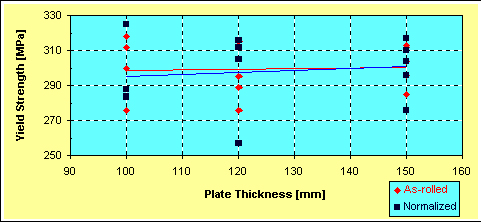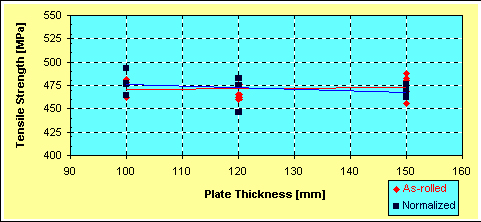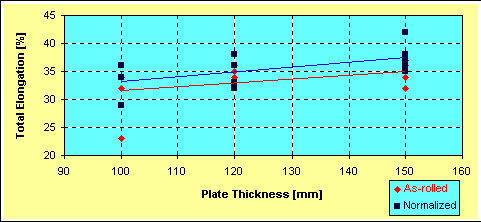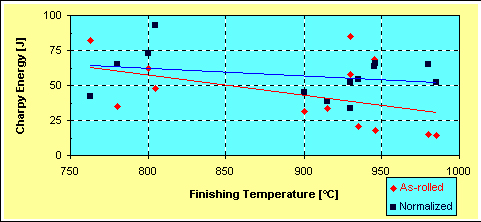
- INTRODUCTION
The continuous casting of slabs became an increasingly popular production route over the last thirty years, not only due to the minimization of the production costs, but also regarding to the better internal sanity of the semi-products that characterize this process. The consequence of this evolution is the progressive vanishing, in a global basis, of the slab production through the hot rolling of conventional ingots, as this route is becoming economically unfeasible for the production of most flat steel products.
The almost complete suppression of this old process is a menace to the production of extra-heavy plates, which still are exclusively produced from slabs originated from conventional ingots. In this specific case, the additional hot working that occurs during slab rolling has a vital contribution to the mechanical characteristics, microstructural homogeneity and internal sanity of the extra-heavy plates. After all, ingots normally have 600 mm of thickness, more than the double of the thickest continuously cast slab. And the stringent standards of hot rolled steel products like, for instance, plates for use at pressure vessels, include the requirement that the thickness of the starting slab must be at least three times the gauge of the final hot rolled product. There has been some controversy about this rule, but it is still valid.
This new situation imposes that new technical alternatives must be found to keep the production of extra-heavy plates feasible. There is a number of solutions that are being presently proposed and executed by several steel plants all over the world:
This is the objective of this work, as COSIPA decided to produce slabs exclusively through the continuous casting route by the end of 1998.
When a 600 mm thick conventional slab is replaced by a 260 mm thick continuously cast slab for the production of a 150 mm gauge plate, there is a decrease of 75% in the global thickness reduction that was originally applied during hot rolling at the slabbing and plate mills. So, in a first approach, extra-heavy plates produced from this thinner continuously cast slabs can have decreased microstructural refining, less segregation homogenization and internal sanity problems.
However, there are some metallurgical counter-measures that can minimize these problems: optimization of the steel alloy design, minimization of the slab reheating temperature, maximization of the effect of the hot rolling process and use of normalization heat treatment. These counter-measures must be applied simultaneously, thus maximizing their effect in the microstructural refining and homogenization.
The addition of some grain size refining elements to steel, like aluminum and titanium, is a good starting point to recover the microstructural refining lost with the use of continuously cast slabs. The minimization of the slab reheating temperature is also a good advice; however, its industrial implementation can be awkward, as it can create restrictions to the production scheduling of the plate mill lines.
The maximization of the effect of the hot rolling process over microstructural refining and homogenization is a important recommendation, as hot forming has a overwhelming effect over plate microstructure and properties. It is necessary to increase hot deformation penetration along rolling stock thickness. In other words: the number of rolling passes must be decreased, with a corresponding increase in the strain degree per pass, promoting thus a better microstructural and segregational homogenizing. Another measures that can be adopted with the same objectives are the reduction of the peripheral speed of the work rolls and an intensified forced cooling of the rolling stock surface. The intensified cooling creates a harder surface in the rolling stock that improves the penetration of the hot rolling strain into the plate core, contributing to its homogenization. The slower rolling speed amplifies this effect.
Also these countermeasures have some drawbacks. Heavier thickness reductions per pass eventually are unfeasible due to load and power limitations of the rolling stand or due to plate flatness considerations. Surface forced cooling overloads the descaling pumps and can create surface cracks in more alloyed steels. Both recommendations also produce an higher spread degree during hot rolling. And, finally, the risk of oil film disruption in the roll chock bearings can prevent the use slower rolling speeds.
The use of an additional normalizing heat treatment, for its turn, can provide further grain refining and a better segregation homogenization to the as-rolled plates. However, it is still necessary to assess quantitatively its beneficial effects to the final product, as it implies in longer processing times and increased production costs.
After the identification of such metallurgical countermeasures for maximizing grain refining and segregation homogenization during hot rolling, the industrial tests at COSIPA could began.
- EXPERIMENTAL DEVELOPMENT
The first development of this kind at COSIPA was carried out with ASTM A36 extra-heavy plates, as this is a product with a great share in the product mix. Three plate thickness were chosen for this study: 100, 120 and 150 mm. Five plates of each thickness were produced for this trial. The experimental plates had width of 2,000 mm and length of 5,000 mm, as products with such dimensions are easily accepted by the Brazilian market. They were rolled from 260 mm thick continuously cast slabs.
The chemical composition of the continuously cast slabs was almost identical to that used for the conventional slabs, but included titanium, which provides an increased degree of microstructural refining to the extra-heavy plates.
The hot rolling of these lighter continuously cast slabs included some special measures: a lower rolling start temperature, use of descaling water jets in all rolling passes and a more heavy thickness reduction per pass than the usual pass schedules. This special rolling process provides a more intensive hot forming effect over microstructural refining and homogenization, which is additionaly intensified by the lower finishing temperature that is achieved due to the use of descaling water jets in all rolling passes. It was decided not to lower the slab reheating temperature due to the great operational and scheduling problems that such measure could bring.
The internal sanity of the extra-heavy plates produced according to this process was determined using ultrasonic testing according to the ASTM A435 standard, which is a typical requisite for this kind of product. The results of such tests were very good, specially considering that techniques like RH degassing of liquid steel were not used in this experiment. However, if necessary, such resource would be available to improve the internal quality of the extra-heavy plates, specially when more stringent internal sanity requirements would be required.
A sample was extracted from each plate for characterization of the as-rolled product. Then the rolling stocks were submitted to the normalizing heat treatment in a controlled atmosphere continuous furnace. After that step, another sample was extracted from each plate for characterization of the normalized product.
Both samples of each plate - in the as-rolled and in the normalized condition - provided specimens for metallographical, tensile and Charpy tests. These specimens were extracted at ¼ thickness and were parallel to the transversal direction of the plate. The Charpy tests were carried out under 0°C.
- EXPERIMENTAL RESULTS AND DISCUSSION
The ideal pass schedules for the production of the extra-heavy plates from continuously cast slabs require that the deformation penetration degree m for each pass would show a minimum value of 0,8. The parameter m is the ratio between the length of the contact arc and the mean of the entry and exit thickness corresponding to that rolling pass. Unfortunately, there were some passes that did not comply with this condition, due to the unavoidable limitations of the industrial plate rolling process: bite condition, maximum limits of rolling load and torque, flatness requirements, and so on. However, all extra-heavy plates were approved in the ultrasonic testing, indicating that the applied pass schedules were able to provide good internal sanity to the product.
Figure 1 shows the relation between the values of yield strength and the corresponding plate thickness. It can be seen that yield strength of all plates satisfied the requirements of the ASTM A36 standard, that is, all values got were greater than 250 MPa, not only for the as-rolled plates but for the normalized ones as well. There was no correlation between the final thickness and yield strength. This was amazing, but indicates that the degree of microstructural refining observed in the thinner plates was not high enough to promote significant changes on yield strength. Surprisingly, also the normalizing heat treatment did not influence significantly the values of yield strength, despite the additional microstructural refining induced by this heat treatment.

The same fact was also observed for the tensile strength, as shown in figure 2. All plates, both in the as-rolled and in the
normalized conditions, satisfied the requirements specified for tensile strength in the ASTM A36 standard, as the values got
were between 400 and 550 MPa. Once more the total thickness reduction showed no influence over mechanical strength. As
previously verified with yield strength, also the tensile strength values of the normalized plates were not significantly different from
the values got from the as-rolled product.

The ductility of plates, as expressed by the specimen total elongation shown after tensile tests, improved as plate thickness grew,
as indicated in figure 3. All values got satisfied the ASTM A36 requirements, as they were greater than 20%. Perhaps the
absence of microstructural banding in the thicker plates contributed to increase ductility. That figure also shows that the
normalizing heat treatment slightly improved the ductility of the extra-heavy plates.

Although ASTM A36 imposes no toughness requirements to the product, this mechanical feature was determined in the plates
of this study, in order to check the process influence over this property. Surprisingly, extra-heavy plate toughness, measured
through Charpy tests at 0°C using transversal specimens, also improved as their thickness increased, as can be seen in figure 4.
This effect was observed both for as-hot rolled and normalized plates and was already pointed out in the literature. Probably this
toughness decrease can be attributed to the increased elongation degree of sulfide inclusions observed in the thinner extra-heavy
plates, which had a greater thickness reduction during hot rolling. The toughness degradation promoted by this increased
inclusion elongation probably is greater than the beneficial effect that would be provided by the extra grain refining that certainly
occurred in the thinner plates. The same figure also shows that the normalizing heat treatment improved toughness. This effect of
the normalizing treatment is widely known, as it promotes grain refining and segregation homogenization without any elongation
of non-metallic inclusions.

The finishing temperature variation did not affect properties like yield strength, tensile strength and total elongation, but effectively
improved toughness, as shown in figure 5. As one can expect from the metallurgical theory, the effect of such temperature was
greater for the as-hot rolled extra-heavy plates, as the steepness of the regression straight line of the graphic absorbed energy
versus finishing temperature is greater for the data corresponding to that material. The subsequent normalizing heat treatment has
a homogenizing effect and tends to dilute the effect of the finishing temperature over plate properties.

- CONCLUSIONS
As no problems regarding internal sanity of the extra-heavy plates were not found and all mechanical properties requisites were satisfied, the pass schedules effectively applied to the continuously cast slabs during the trials here described were adequate for the production of ASTM A36 plates in gauges from 100 to 150 mm. However, this was true only when the ultrasonic tests for assessing internal sanity were carried out satisfying the ASTM A435 standard requirements. Higher levels of internal sanity imposed by more stringent standards, e.g. like SEL, certainly would require RH degassing during the refining of the molten steel, as well more heavier thickness reductions per pass during plate rolling.
The total strain applied during hot rolling did not affect significantly mechanical strength considering the range applied in this study. However, increasing the thickness reduction during hot rolling decreased both ductility and toughness, perhaps due to the increased degree of elongation of the sulfide inclusions and the appearance of microstructure banding.
For its turn, the reduction of finishing temperature improved toughness, but had no effect over mechanical strength and ductility.
A subsequent normalizing heat treatment did not affect significantly mechanical properties, with the exception of ductility and toughness, which showed a slightly improvement. This heat treatment apparently would be mandatory for the production of more sophisticated steel grades with stringent toughness requirements, specially for the thickest (150 mm) plates, despite its additional cost and longer processing time.
This work constituted only the initial step of COSIPA on this critical subject. New developments on new alloy designs and molten steel refining, solidification and hot rolling processes are being carried out to make feasible the production of plates from continuously cast slabs according to new product standards. Some of them are well more severe than the ASTM A36 requirements in terms of internal sanity and toughness. All this effort must be done as it is being required by the Company most valuable resource: its customers.

 |
Last Update: 03 August 2000 | |
| © Antonio Augusto Gorni |